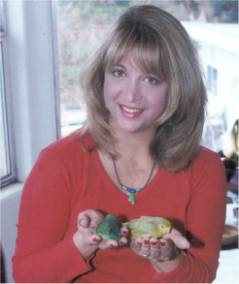Friday, September 13, 2013
New Baby Parrotlet with AGY, Watery Droppings
Hi, Sandee!
I've owned tame budgies for years, but now I have just one budgie and a sweet baby parrotlet, Pocket. I acquired Pocket at six weeks of age, not knowing that getting a not-quite-weaned baby is a bad idea. However, we have been doing well with that, Pocket and I - he has gradually been gaining weight and seems just about weaned - I still offer formula twice a day (sound OK?).
I took him to an avian vet after the first week for a well-baby check, also because his droppings were occasionally watery, and he just didn't seem to have the same voracious appetite as my budgie. The vet gave him a clean bill of health, except she did say that a small amount of AGY showed up in his dropping. I've bought and read your handbook, but am still a bit concerned about that - do I need to worry at all, or should I not be concerned as long as he continues to thrive?
Also, what in the heck do "normal" parrotlet droppings look like, anyway? He still occasionally has watery droppings (solid wormy part with watery stuff around it, otherwise his droppings are kind of a very moist tan wormy-like thing.
He's pretty adventurous when it comes to trying new foods - is eating some veggies, brown and wild rice, apple, Nutriberries and lots of millet. Sound OK?
Thanks for any help you can give (I feel like such a newbie) - love your blog!
Mary Kinsley
P.S. The budgie and Pocket are kept very separate!
Dear Mary:
Thank you for your message. Little Pocket sounds like a delight!
Most Pacific parrotlets are weaned at six weeks; 7 at the most. It is not unusual for them to revert a bit and accept formula once they have been sold and gone to their new homes due to the stress. However, this is usually something that makes the owners feel better and usually isn’t ‘necessary’ for the bird to survive. Making sure the parrotlet is eating real food is very important at this stage and its always wise to make sure they have as much millet as they wish as well as a wide variety of fresh foods. Millet has both protein and carbohydrates, nutrients needed by baby parrotlets to both grow strong and healthy as well as insure proper nutritional support throughout this transition. The most important things to get the bird to eat are vegetables. Fruit is ok but most parrotlets are not big fruit eaters unless its apple or things that have a lot of seeds in them like kiwi or berries. Greens and cooked legumes are also very important.
Feeding a parrotlet hand-feeding formula will increase the urates (watery) part of the droppings. That is perfectly normal and is what is expected.
AGY is a naturally occurring yeast in all birds and is normal. Again, during periods of stress, their bodies may produce more of it which can be detected in droppings but unless the bird is clinically ill, it is not considered a problem and most vets familiar with it do not believe in medicating the bird. It generally clears up on its own.
Pocket sounds like a very lucky bird to have you as an owner. Best of luck and I hope this helps!
Sincerely yours,
Sandee L. Molenda, C.A.S.
The Parrotlet Ranch, Owner, www.parrotletranch.com
A Chattering Bird Builds No Nest.
Camaroonian Phrase
Labels:
AGY,
Baby Parrotlet,
Hand-Feeding,
Nutrition,
Parrotlet,
Weaning
Subscribe to:
Post Comments (Atom)




No comments:
Post a Comment
Note: Only a member of this blog may post a comment.